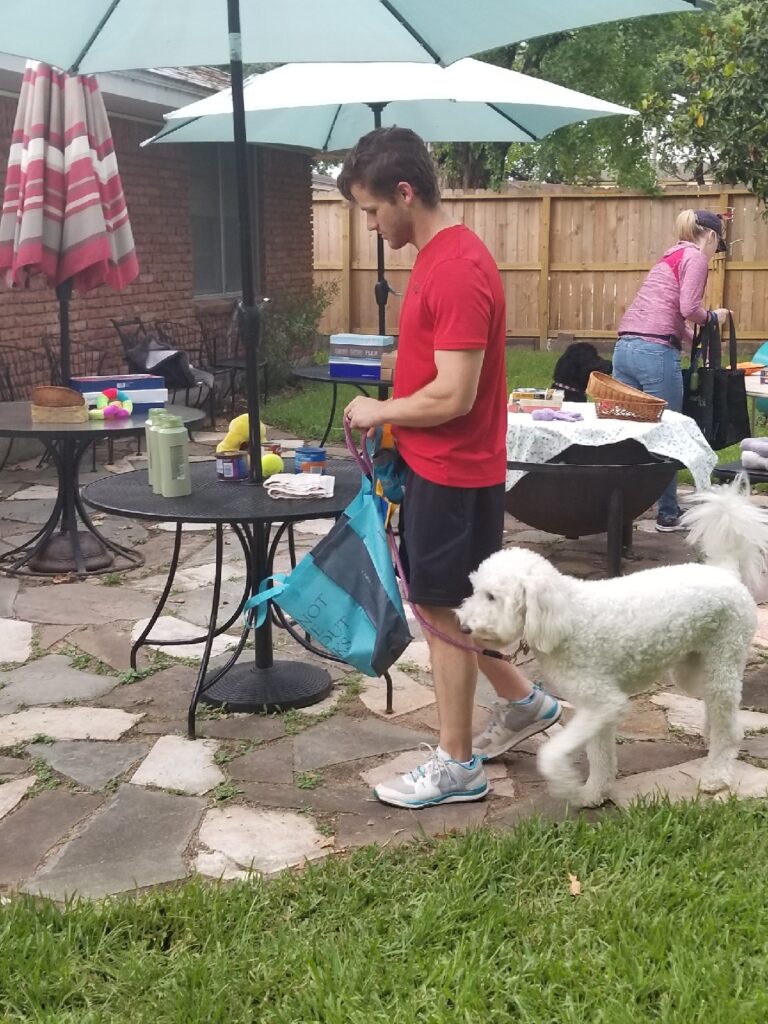- Leash Skills Series #1: Walking a dog
- Leash Skills Series #2: Defining Leash Walking
- Leash Skills Series #3: Leash Training Teamwork
- Leash Skills Series #4: Starting Leash Training
- Leash Skills Series #5: Why a Loose Leash?
- Leash Skills Series #6: Training with Treats – Treats = training tools!
- Leash Skills Series #7: Limitations of “Be a Tree”
- Leash Skills Series #8: Positive Reinforcement for Humans
Are you walking a dog or flying a kite?
What guides your dog when the two of you are walking? Is it the leash itself? Or on the other hand, does your dog watch you to see where you go, with a loose leash between you? Some dogs and owners use a tight leash as their guide. These dogs are used to pulling their humans along behind them. They typically don’t drag hard on the leash and they respond to changes in direction as the owners pull to make turns or stop. It’s a little like flying a kite: a certain level of tautness in the line keeps the kite floating on the air, and the human has some influence on the position of the kite. If the kite comes down, the human can pull it to them by the string. Humans can pull their dogs to them with leashes, but it can be pretty unpleasant for the dog.
What will you do if a problem occurs?
If you follow the same route every day and the dog has experience with this tight-leash technique, it works pretty well – until something unexpected happens. The dog is out in front of you, so he can drag you toward anything he’s interested in: someone with an out-of-control dog, something on the ground he wants to sniff or eat. Any control you have comes from pulling hard on the leash. The resulting tension on the dog’s neck or body is unpleasant. The dog can easily make bad associations between discomfort from the leash and things he encounters. These bad associations can result in your leashed dog barking and lunging, even though she shows friendly gestures off leash. It even has a name – “leash reactivity” – and good leash skills can prevent it.
The tight-leash technique may not extend to your next dog. That next dog may become aroused and stressed as she pulls mightily on the leash. If your leash technique is to have the dog out in front on a tight leash, you won’t be prepared to help a dog like this reduce stress and learn to enjoy walks.
Don’t limit yourself to the tight-leash technique. If you look closely, you may find you aren’t enjoying walks with your dog as much as you could be. How you learn to handle a leash can make all the difference for your dog, yourself, and any other dogs you come into contact with.
A vision of a better way to walk together: Loose Leash
Great leash skills build great partnerships between dogs and humans. Consistent skill training creates a strong bond that allows you to control the situation, allowing safe and enjoyable walks for you and your dog. Having good leash skills prepares you to adjust your behavior to walk with any dog that comes along. In turn, practice with every dog that comes along helps you maintain our skills. People are really into fostering rescue dogs these days. Being good at handling a leash can help any dog reduce stress and gain opportunities to participate in more experiences.

Good leash skills give you and your dog opportunities
Many dog-friendly stores are available to polite, mannerly dogs and their owners these days. Hardware stores, nurseries, sporting goods stores and hobby stores happily allow dogs inside. Check their websites or signage on front doors to make sure. Some patio restaurants invite dogs to join their owners for a meal or snack. A few companies even observe “Take Your Dog to Work Day.”* These businesses are likely to continue to do so as long as the dogs and owners are well-behaved and polite, with good leash skills.
Of course, there’s always the possibility that someone will use poor judgment and bring a nervous, reactive, or poorly trained dog in and ruin the opportunity for others. Don’t be that person! You and your dog can have great leash skills that keep you physically and behaviorally safe. Create good associations so you both look forward to your next walk or trip to a dog-friendly store. Don’t let your dog be the one that’s confused and stressed-out. Don’t let your dog be in a situation where he doesn’t have the skills he needs to manage himself. Good leash skills create opportunities for everyone.
* We’re well into the COVID-19 pandemic, and everything is different now! I’m holding onto memories of some of the good things in the “way things used to be” times. Working at home is a little like “Take Your Dog to Work Day,” every day! What a great time to practice leash skills, giving your dog a fun activity and a way to earn treats during work breaks!
Good leash skills reduce stress and prevent arousal
If you foster rescue dogs or work as a volunteer with a shelter or rescue group, you need leash skills. Good leash skills help you take dogs into a variety of situations, starting with a stress-free walk on a loose leash. The more different situations in which a dog can feel comfortable, the better he learns the good manners he needs. Pay attention to what your dog is telling you so you can respond to him in a way that helps him give you behaviors you like.
If you learn only one thing about leash skills, let it be that you have the power to keep the leash loose. A loose leash will reduce stress, anxiety, and arousal. A loose leash will facilitate your dog solving the problem of how to walk with you as a partner. Let your body language, voice, and treats do the work of getting dogs to walk with you. As a result, the leash will simply be an extra safety device in an emergency situation.
Attention Shelter, Clinic, and Rescue Group Staff and Volunteers: The Mannerly Dog offers a complimentary online Dog Reading Course just for you! The course has been proven to increase understanding of dog body language. Request it here and we’ll send you a link.
(We also offer a similar course in Reading Cat Body Language! Request it here.)
[wpforms id=”1300″]
Leash Skills Series #6: Training with Treats – Treats = Training Tools


